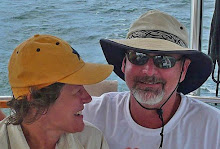
We hadn’t even gotten our anchor down when we were met by the port captain, customs, immigration, health inspector and Raul who was to become our agent and took care of all the clearing in procedures for us. Our cockpit was soon full of officials and I think Susan made friends by the ice tea she passed out to all 7 of our visitors on this hot afternoon. We don’t speak Spanish very well but a cool drink and a smile does a lot to cut across language barriers.

I must say that it exceeded all my expectations, which were pretty high to begin with. Just behind the town of Livingston the hills raise so steep and tall they almost seem to be mountains. We took Gypsy through those hills. Only a mile from the mouth of the river we entered the gorge, which was spectacular. The walls of the gorge are thick with vegetation, mostly huge trees of all types imaginable that grow from the impossibly steep banks of the river which is 200’ or 300’ at its highest.

We have a good guidebook for the river (Freya Rauscher’s 3rd edition), which was a huge help and still not all hazards are listed and one must remain vigilant on this river. We got a few GPS waypoints from Raul that proved very helpful.

Birds of all types were flying about and some even landed on Gypsy. We saw egrets by the score: egrets flying, fishing, stalking the banks, trees full of egrets and egrets soaring in front of the huge jungle cliffs which provided a stunning verdant background for these startling white birds. Besides being surrounded by the visual beauty we were soon enveloped in all the astonishing and exotic sounds and smells of the jungle.

We also saw dozens and dozens of graceful dugout-canoes being paddled and fished from all up and down the river. The local watercraft are slender and low slung and are paddled with such great skill that they seem to glide almost effortlessly across the water.

The river varied in depth from 8.5’ to 80’, mostly it ran in the 30’ to 50’ range. Safe but demanding one’s complete attention in some spots. At other times my attention to navigation was severely challenge by the beauty of our surroundings.

At one point I was taking a photograph while at the helm when Susan let out a yell and grabbed the wheel. I had gotten so lost in the beauty of the place, lost track of our course. We were heading straight for the nearby bank of the river when Susan intervened.

From time to time we saw grass huts along the banks where the terrain was gentle enough to allow habitation. We witnessed people gathering wood, fishing, traveling and even doing laundry in the river. This river truly is the lifeblood of all the inhabitants that live and work along it.

Because we had left Livingston late in the day we stopped for the night at Texan bay, which is 6 nm up the river from Livingston. It’s the first little bay in the wide part of the river called El Golfete. We dropped anchor in 12’ of water and watched enchantedly as a couple of young kids in a canoe fished with a cast net next to Gypsy in the late afternoon light.

As we watched the sun set on the river I remarked to Susan; “If this was the only thing we did on our entire trip, just this one day, it would all have been wroth it”.

Once out of Texan bay we were in El Golfete, a section of the river that gets up to 3 miles wide. It was about 9:00 when we arrived at our marina. (the photo below is what we saw upon our arrival) We anchored out front and dinghied in to find out where to tie up.

We were fortunate to end up with a side-tie on the end of the dock. It’s an easy approach and we don’t have to use our anchor as some of the med-tied boats have to do. Plus we seem to get a little extra breeze where we are which is much appreciated.

I must say that I’m thrilled and amazed by the Rio and we’ve only just arrived.


